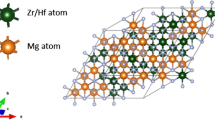Abstract
We propose a method for calculating the electronic band structure of disordered systems with strong electron correlations. Various approaches to the description of electrical conductivity of disordered systems are considered. Calculations are based on determining the one-particle Green function of the system, which is averaged over different configurations of a cluster, on the Boltzmann formalism, and the Kubo linear response theory. As the basic model, we use the Hubbard model for an A1 – xBx binary alloy.






Similar content being viewed by others
REFERENCES
R. J. Elliott, J. A. Krumhansl, and P. L. Leath, Rev. Mod. Phys. 46, 465 (1974).
J. Ziman, Models of Disorder: The Theoretical Physics of Homogeneously Disordered Systems (Cambridge Univ. Press, Cambridge, New York, 1979).
I. M. Lifshits, S. A. Gredeskul, and L. A. Pastur, Introduction to the Theory of Disordered Systems (Nauka, Moscow, 1982; Wiley, New York, 1988).
R. Mills and P. Ratenavaraksa, Phys. Rev. B 18, 5291 (1978).
V. F. Los’ and S. P. Repetsky, J. Phys.: Condens. Matter 6, 1707 (1994).
S. P. Repetsky, Ye. G. Len, and N. V. Chubinsky, Met. Phys. Adv. Tech. 17, 867 (1999).
S. P. Repetskii, V. B. Molodkin, I. G. Vyshivanaya, E. G. Len’, I. N. Mel’nik, O. I. Musienko, and B. V. Stashchuk, Usp. Fiz. Met. 10, 283 (2009).
M. A. Krivoglaz and A. A. Smirnov, Ordering Alloy Theory (Fizmatgiz, Moscow, 1958) [in Russian].
S. M. Borodachev, V. A. Volkov, and S. I. Masharov, Fiz. Met. Metalloved. 42, 1147 (1976).
P. W. Anderson, Phys. Rev. 109, 1492 (1958).
L. P. Gor’kov, A. I. Larkin, and D. E. Khmel’nitskii, JETP Lett. 30, 228 (1979).
E. Abrahams, P. W. Anderson, D. S. Licciardello, and T. V. Ramakrishnan, Phys. Rev. Lett. 42, 673 (1979).
G. Bergmann, Phys. Rep. 107, 1 (1984).
R. Flederling, M. Kelm, G. Reuseher, M. Ossau, G. Schmidt, A. Waag, and L. W. Molenkamp, Nature (London, U.K.) 402, 787 (1999).
G. A. Prinz, Phys. Today 48, 5863 (1995).
S. Borukhovich, Phys. Usp. 42, 653 (1999).
D. Senechal, D. Perez, and M. Pioro-Ladriere, Phys. Rev. Lett. 84, 522 (2000).
D. Senechal, D. Perez, and D. Plouffe, Phys. Rev. B 66, 075129 (2002).
E. Dagotto, T. Hotta, and A. Moreo, Phys. Rep. 344, 1 (2001).
E. Dagotto, Nanoscale Phase Separation and Colossal Magnetoresistance (Springer, Berlin, 2003).
S. V. Nikolaev and S. G. Ovchinnikov, J. Exp. Theor. Phys. 111, 635 (2010).
S. V. Nikolaev and S. G. Ovchinnikov, J. Exp. Theor. Phys. 114, 118 (2012).
M. W. Haverkort, I. S. Elfimov, and G. A. Sawatzky, arXiv: 1109.4036v1 [cond-mat.mtrl-sci].
M. V. Sadovskii, Phys. Usp. 44, 515 (2001).
E. Dagotto, Rev. Mod. Phys. 66, 763 (1994).
G. D. Mahan, Many-Particle Physics (Springer, US, 2000).
D. J. Scalapino, Phys. Rev. B 47, 7995 (1993).
ACKNOWLEDGMENTS
The authors are grateful to Prof. S.G. Ovchinnikov for discussion of the results and for valuable remarks.
Funding
This study was supported by the Foundation “Basis” for development of theoretical physics and mathematics, Russian Foundation for Basic Research (project no. 19-03-00017), Government of Krasnoyarsk Territory and Krasnoyarsk Regional Fund of Science according to the research project “Electronic correlation effects and multiorbital physics in iron-based materials and cuprates” (no. 19-42-240007) and research project “Features of electron-phonon coupling in high-temperature superconductors with strong electronic correlations” (no. 18-42-240017).
Author information
Authors and Affiliations
Corresponding authors
Additional information
Translated by N. Wadhwa
Rights and permissions
About this article
Cite this article
Nikolaev, S.V., Orlov, Y.S. & Dudnikov, V.A. Electronic Structure and Conductivity of a Disordered A1 – xBx Binary Alloy in the Cluster Approach for the Hubbard Model. J. Exp. Theor. Phys. 131, 823–837 (2020). https://doi.org/10.1134/S1063776120100131
Received:
Revised:
Accepted:
Published:
Issue Date:
DOI: https://doi.org/10.1134/S1063776120100131




